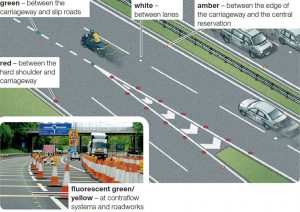You will commonly find 4 differently coloured reflective studs on UK roads. Each colour has a different purpose and conveys a specific message as laid out by Rule 132 of the Highway Code. The colour of reflective studs between a motorway and its slip road will be green. When you see green reflective studs you should take note that there is a slip road joining the main carriageway of the motorway. People may be turning on to or off from the motorway ahead. As such, you should adjust your speed appropriately and check your mirrors carefully.
What do each of the reflective stud colours show?
 All of the reflective studs will be used in conjunction with white lines and convey the following messages:
All of the reflective studs will be used in conjunction with white lines and convey the following messages:
- White studs – are used to show the separation between lanes on either a motorway OR a dual carriageway. When used on a road with a single carriageway they show road users where the middle of the road is.
- Red studs – are used to indicate the edge of the motorway or road on the left-hand side.
- Amber studs – are used to indicate the central reservation on a dual carriageway or motorway. As such, they indicate the edge of the road on the right-hand side.
- Green/yellow studs – are used when there are temporary alterations to the road layout on motorways or roads. They indicate temporary new lane layouts.
Theory Test Question
So, how did you find the example question from a theory test? Let’s consider each of the answers to check your understanding:
Green
Correct! Green reflective studs are used between a motorway and its slip road.
White
Wrong! White reflective studs are used to mark the separation between lanes on dual carriageways and motorways or the middle of the road on a road with a single carriageway.
Red
Wrong! Red reflective studs are used to mark the left-most edge of the road or motorway.
Amber
Wrong! Amber reflective studs are used to mark the central reservation on a motorway or dual carriageway.


